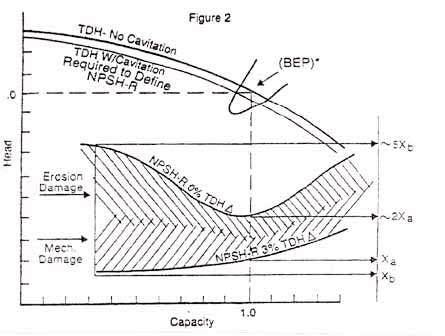Fooooks
Mechanical
- Sep 15, 2016
- 48
Hello all,
We are currently having two issues with our existing PD pumps that we use to unload rail cars. They are cavitating and aerating due to the varying product levels in the rail cars. We typically unload from multiple cars simultaneously, and this makes it difficult for our operators to determine when suction pressure gets too low (outside of a pressure gauge on the suction of the pump) or that a tank car is empty and they are pulling air into the pump. Operators will run the pump full speed (connected to an existing VFD for speed control) and slow it down only when the pump starts to vibrate excessively or they hear the noises associated with cavitation/aeration in the pump.
Design
I will be adding a positive displacement pump for the purpose of unloading vegetable oil from these rail cars. A VFD will be added that will be tied into a suction pressure transmitter. The vegetable oil has an assumed vapor pressure of 0.02 psia, S.G of 0.9, and a viscosity ranging from an estimated 75-300 cst depending on temperature. The pump we are using has an NPSHR at design speed of 8.6 ft. After running some calculations, the NPIP (Net positive inlet pressure) for the pump would be approximately -10 psig. The VFD will theoretically be tied to a suction pressure transmitter so as to decrease the motor speed when the suction pressure gets too low. This would theoretically protect the pump from cavitating by increasing NPSHA. What do you all think of this design? The only problem I am having is how to protect the pump from aerating when rail cars empty while the pump is still running. We would want to completely pump all of the product from the rail cars and suction line if possible.
Cavitation Questions
After considering this system, it made me dive deeper into the NPSHA > NPSHR rule. Everywhere I have read said this is to prevent cavitation and "starving" the pump. But if the vegetable oil has a vapor pressure of approximately 0.02 psia, does this mean that when the NPSHA drops below NPSHR, there is essentially a complete vacuum at the inlet of the pump, causing flashing of a vegetable oil?
I can see this clearly when thinking about water or a hydrocarbon, but it seems strange that vegetable oil would be able to flash in a similar fashion. Can someone explain what is actually happening locally to the vegetable oil? Is the vacuum really flashing the oil if there is vapor space in the pipeline or the pump, assuming no air entered the system?
I am hoping to get some insight which may help the design.
Thanks!
We are currently having two issues with our existing PD pumps that we use to unload rail cars. They are cavitating and aerating due to the varying product levels in the rail cars. We typically unload from multiple cars simultaneously, and this makes it difficult for our operators to determine when suction pressure gets too low (outside of a pressure gauge on the suction of the pump) or that a tank car is empty and they are pulling air into the pump. Operators will run the pump full speed (connected to an existing VFD for speed control) and slow it down only when the pump starts to vibrate excessively or they hear the noises associated with cavitation/aeration in the pump.
Design
I will be adding a positive displacement pump for the purpose of unloading vegetable oil from these rail cars. A VFD will be added that will be tied into a suction pressure transmitter. The vegetable oil has an assumed vapor pressure of 0.02 psia, S.G of 0.9, and a viscosity ranging from an estimated 75-300 cst depending on temperature. The pump we are using has an NPSHR at design speed of 8.6 ft. After running some calculations, the NPIP (Net positive inlet pressure) for the pump would be approximately -10 psig. The VFD will theoretically be tied to a suction pressure transmitter so as to decrease the motor speed when the suction pressure gets too low. This would theoretically protect the pump from cavitating by increasing NPSHA. What do you all think of this design? The only problem I am having is how to protect the pump from aerating when rail cars empty while the pump is still running. We would want to completely pump all of the product from the rail cars and suction line if possible.
Cavitation Questions
After considering this system, it made me dive deeper into the NPSHA > NPSHR rule. Everywhere I have read said this is to prevent cavitation and "starving" the pump. But if the vegetable oil has a vapor pressure of approximately 0.02 psia, does this mean that when the NPSHA drops below NPSHR, there is essentially a complete vacuum at the inlet of the pump, causing flashing of a vegetable oil?
I can see this clearly when thinking about water or a hydrocarbon, but it seems strange that vegetable oil would be able to flash in a similar fashion. Can someone explain what is actually happening locally to the vegetable oil? Is the vacuum really flashing the oil if there is vapor space in the pipeline or the pump, assuming no air entered the system?
I am hoping to get some insight which may help the design.
Thanks!

